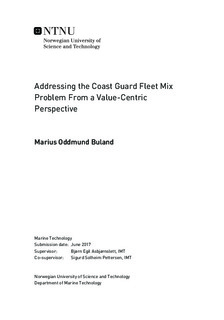Addressing the Coast Guard Fleet Mix Problem From a Value-Centric Perspective
Master thesis
Permanent lenke
http://hdl.handle.net/11250/2456895Utgivelsesdato
2017Metadata
Vis full innførselSamlinger
- Institutt for marin teknikk [3431]
Sammendrag
The decision to acquire a fleet of coast guard vessels is typically irreversible and of longterm impact. Once vessels are bought and built, they typically remain within the fleet for a few decades. This emphasizes the importance of acquiring vessels that can remain valuable to involved stakeholders throughout their life-cycle. However, determining the optimal coast guard fleet structure is difficult due to its complexity. The coast guard fleet mix problem is particularly complex since the problem involves determining which vessel capabilities that are needed, as well as how the fleet is to be utilized. In contrast to commercial maritime fleets, where accomplished missions often yields monetary profit, a coast guard's accomplished tasks are often represented as non-monetary values. Recommending a sufficient fleet structure might therefore be somewhat diffuse as it is difficult to measure the return of these types of investments.
Over the past years, system success has been closely related to requirements and/or cost related characteristics, especially within defense acquisition programs. Due to the presence of endogenous and exogenous uncertainties, decision-makers have often tried to maximize system capability as a consequence to high marginal costs. This has often resulted in highly complex system solutions at very high cost levels which somehow ends up short in delivering their full potential. This is due to a requirement-centered mindset, and the literature suggests that decision-makers should consider value-centric design and decision methodologies.
Using the Responsive Systems Comparison method, an illustrative case study is presented focusing on assessing the coast guard fleet mix problem from a value-centric perspective. The model incorporates a set of vessel designs which are evaluated using a multi-attribute utility aggregation model. To capture future uncertainty, a set of epoch variables are established to represent potential future operating contexts. The results from the case study show that the main benefit of using the Responsive Systems Comparison method is that it allows decision-makers to include different stakeholder objectives and attribute preferences when evaluating different coast guard fleet solutions. This enables dialog and knowledge building towards finding fleet solutions that will continue to deliver value to involved stakeholders over the fleet's life-cycle. However, due to the selected multi-attribute utility aggregation model and lack of realistic data, making a recommendation of sufficient fleet structure is difficult, as the model is not able to consider operational attributes.
To improve the case study, further work on the problem should aim to collect data that can be used to represent more realistic epochs. What is particularly interesting for further consideration is how combining fleet size and mix models and simulation models with the Responsive Systems Comparison method might increase the tradespace exploration process, as it aligns the perspectives on value-centric decision making with well documented optimization algorithms. Introducing these models with the Responsive Systems Comparison method might help to describe how capable different fleet structures, presented in a tradespace, might be in responding to different contextual situations. This will hopefully enhance decision-makers' and involved stakeholders' understanding of how many vessels that are actually needed, and which vessel capabilities to include in the vessel designs by scoping cost-utility tradeoffs. Other attributes, design variables and epoch variables considered important for the coast guard fleet mix problem should be investigated.
